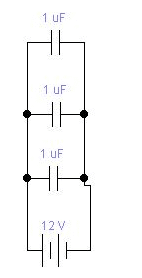Combination of capacitance in series and parallel circuit
There are two combinations of capacitors series and parallel circuits. In series circuits, the total capacitance is less than the smallest capacitance value because the effective plate separation increases. In parallel circuits, the total capacitance is the sum of individual capacitance.
-
Series combination
when capacitors are connected in series, the total capacitance is less than the smallest capacitance value because the effective plate separation increases. The calculation of total series capacitance is analogous to the calculation of total resistance of parallel resistors.


This type of combination has the following characteristics:
- Each capacitor has the same charge across it. If the battery supplies +Q charge to the left plate of the capacitor C1 due to induction -Q charge is induced on its right plate and +Q charge on the left plate of the capacitor C2 i.e
Q= Q1 +Q2 +Q3
2:The potential difference across each capacitor is different due to different values of capacitances.
3:The voltage of the battery has been divided among the various capacitors. Hence
V=V1 +V2 +V3
= Q/C1 +Q/C2 +Q/C3
=Q[ 1/C1 + 1/C2 + 1/C3]
V/Q=[ 1/C1 + 1/C2 +1 /C3]
4:Equivalent capacitance
we can replace a series combination of capacitors with one equivalent capacitor having capacitance Ceq i.e,
1/Ceq = 1/C1 + 1/C2 + 1/C3
Formula for total capacitance in parallel circuit
When capacitors are connected in parallel, the total capacitance is the sum of individual capacitances because the effective plate area increases. The calculation of total parallel capacitance is analogous to the calculation of total series resistance.

In the above figure, the left plate of each capacitor is connected to the positive terminal of the battery by a conducting wire. In the same way, the right plate of each capacitor is connected to the negative terminal of the battery. This type of combination has the following characteristics.
- Each capacitor connected to a battery of voltage V has the same potential difference as:
V= V1 +V2 + V3
2. The developed across the plates of each capacitor will be different due to different values of capacitances.
3. The total charge Q supplied by the battery is divided among the various capacitors. Hence:
Q = Q1 +Q2 +Q3
Or Q=C1V + C2V+C3V
Q=V(C1 +C2+C3)
Q/V=C1 +C2+C3
4. We can replace the parallel combination of capacitors with one equivalent capacitor having capacitance Ceq, such that
Ceq=C1 + C2 +C3
In the case of n capacitors connected in parallel, the equivalent capacitance is given by:
Ceq=C1 +C2 +C3+……+Cn
5. The equivalent capacitance of a parallel combination of capacitors is greater than any of the individual capacitances.
Watch also video
Recent Posts
Is energy quantized in classical physics?
No, according to classical wave theory the emission of electromagnetic radiations from the surface is…
Types of laser
Basically, there are four types of laser which includes: Gas Lasers Solid State lasers Liquid…
Ultrasound frequency range
What is ultrasonics? The study and application of mechanical vibrations with frequencies beyond the limits…
Electromagnetic Energy: What are some examples of it?
Electromagnetic energy definition Electromagnetic energy is the amount of energy stored in a region of…
Fundamental units and Derived Units with Examples
The Main Difference between fundamental Units and Base units is that Units that Express base…
Newton’s First law of Motion Examples in Our Daily Life
Newton's first law of motion states that " A body continues its state of rest…

